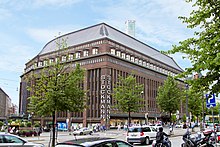Stockmann Helsinki
Stockmann's department store in the center of Helsinki ( Finnish. Stockmannin Helsingin keskustan tavaratalo ) is the largest department store in Finland and the Nordic countries . It has been a landmark in the center of Helsinki since 1930 and, with over 50,000 square meters of retail space, is the parent company and main business of Stockmann Oyj ( AG ).
Location and importance
The department store complex now takes up a whole block in the Kluuvi ( Swedish: Gloet ) district on Mannerheimintie , Aleksanterinkatu , Keskuskatu and Pohjoisesplanadi streets . During the last renovation in 2010, the sales area was increased to 50,167 m², making it the third largest department store in Europe. Harrods in London has 90,000 m² and the Kaufhaus des Westens in Berlin ranks second with 60,000 m². The department store had 17 million visitors in 2006 and sales of 350 million euros in 2002.
history
In 1916 a competition was held for a new department store by the Stockmann company, which was founded in 1862. The winner was the architect Valter Thomé (1874–1918) with his brother Ivar (1882–1918), who both perished in the civil war . The building could only be executed in the 1920s by the second laureate Sigurd Frosterus (1876–1956) based on the drawings of the Thomés in the style of Nordic Art Deco . The department store was completed in 1930 and was the second in the country to be equipped with escalators after the “Forum” department store in Turku (1926) .
The academic bookstore "Akateeminen kirjakauppa" was acquired in 1930 and subsequently moved to the department store. In 1969, their range moved to a new building designed by star architect Alvar Aalto .
During the Second World War, the building received four bombs on February 26, 1944, which destroyed the glass roof of the atrium and many window panes. As a result, the water and heating pipes were destroyed by the frost.
In 1986/1987 the neighboring Argos building, completed in 1897, was completely gutted and integrated into the Stockmann building. At the southwest corner of the block, it forms the connection between the main building from 1930 and the modern expansion from 1989. During the last construction work from 2007 to 2010, the sales area was expanded by over 20 percent while operations continued. The building has been increased by two to eight floors, and guests in the restaurant can look into the atrium from the top floor. Another 200,000 cubic meters of space could be gained by penetrating up to 30 meters into the rock. Among other things, the size of the parking garage was tripled to 600 vehicles. Since then, the department store has had a total of ten floors, two of which are underground (without mezzanines). At the same time, the technical infrastructure of the property was renewed.
In the Helsinki area there are currently (2017) further department stores of the group in Helsinki-Itäkeskus, in Tapiola (since 1981), Espoo and Vantaa .
useful information
- The Stockan kello clock in the main entrance is a popular meeting place for meetings.
- Since 1986 the "crazy days" ( hullut päivät ) have been held every year with bargains and special offers .
- In 1952, a competitor's SOKOS department store was opened, about 250 meters from Stockmann. ( (Location) )
- In the fall of 1950, Finland's first television broadcasts took place in shop windows.
- The first "S" of the current Stockmann logo represents escalators. It is often misunderstood that it was the first escalators in the country in 1930.
literature
- Damstén Birger: Kauppahuone Stockmann: viidenkahdeksatta vuoden vaiheet 1862–1937. Helsinki, Stockmann 1937.
- Damstén Birger: Stockmann sadan vuoden aikana. Tillgmannin kirjapaino Helsinki 1961.
- Finnilä Anna: Stockmann: suuri tavaratalo = det stora varuhuset = the grand department store. Helsingin kaupunginmuseo, 1993. ISBN 951-772-354-7 .
- Standertskjöld Elina: Arkkitehtuurimme vuosikymmenet 1930–1950 . Suomen rakennustaiteen museo, 2008. ISBN 978-951-682-875-9 .
Web links
- Stockmann.com: Official website of the department store (Finnish, Swedish, English)
- DEPARTMENTS IN HELSINKI CITY CENTER. (English, structure and departments of the department store)
Individual evidence
- ↑ Helminen Matti: Helsingin suurpommitukset helmikuussa 1944 . WSOY, 2004. p. 99
- ↑ Standertskjöld Elina: Arkkitehtuurimme vuosikymmenet 1930–1950 . Suomen rakennustaiteen museo, 2008. pp. 149f.
Coordinates: 60 ° 10 ′ 6 ″ N , 24 ° 56 ′ 32 ″ E






